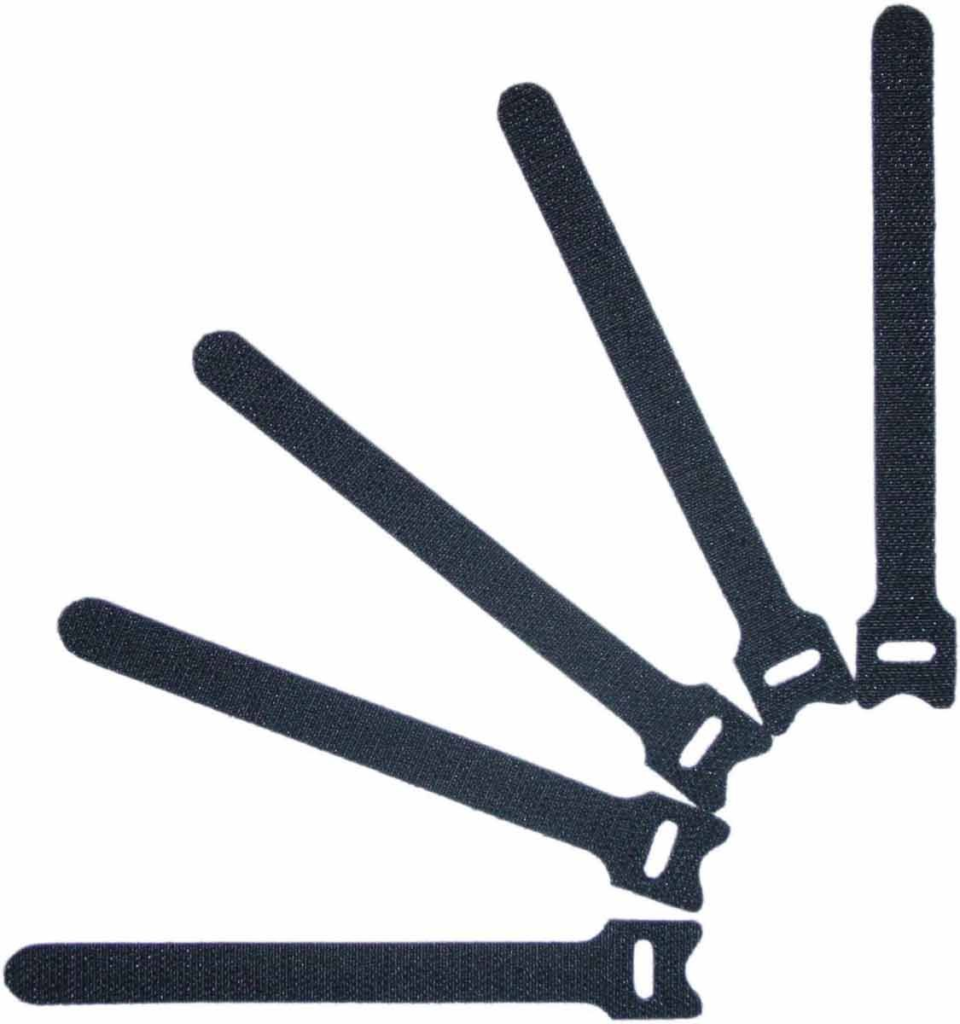Cord management has always been a significant concern, particularly for those who work with multiple devices. Traditional cable ties are one approach, but they lack reusability and can be challenging to adjust. Enter hook and loop cable ties, which have recently gained prominence as an alternative to more traditional methods.
Offering reusability and easy adjustments, hook and loop cable ties make cord management a more efficient process. In this article, we'll explore the applications, benefits, and some guidelines for choosing the right hook and loop cable ties for your needs.
What Are Hook and Loop Cable Ties?
Hook and loop cable ties, often referred to as Velcro cable ties, consist of two separate components. One side contains tiny hooks, while the other side has loops. When pressed together, they create a secure, yet easily adjustable bond. These ties are often fabricated from nylon, which adds to their durability and reusability.
By avoiding the single-use nature of traditional zip ties, hook and loop options contribute to less waste. They're perfect for applications where adjustments are frequently necessary, like in a recording studio or a data center.
Applications and Use Cases
Office Settings
In office environments, hook and loop cable ties are a godsend. They manage the numerous cords running from your computer, phone, and other devices to power outlets and data ports. They're easy to remove and readjust, making them particularly useful during relocations or office reconfigurations.
Home Entertainment Systems
Your home theater system with its array of gadgets—TV, soundbar, streaming devices—can result in a mess of cords. Hook and loop cable ties offer an easy and efficient way to keep everything organized. And if you decide to add another component to your setup, adjusting the ties is a breeze.
Industrial Applications
Industrial settings require robust and reliable solutions for managing cables. Hook and loop cable ties can withstand considerable wear and tear, making them suitable for harsh environments. They're commonly used in machinery, server rooms, and other areas where heavy-duty cable management is required.
Key Benefits of Hook and Loop Cable Ties
Reusability Factor
One of the primary advantages of hook and loop cable ties is their reusability. Traditional ties often have to be cut and discarded if you need to make adjustments, leading to more waste. Hook and loop models can be reused multiple times, saving both resources and money.
Durability and Strength
Despite their ease of use, these cable ties don't compromise on strength. High-quality hook and loop cable ties can support considerable weight, making them suitable for both light and heavy-duty applications. Their durability also ensures they can last for an extended period, further emphasizing their cost-effectiveness.
Choosing the Right Hook and Loop Cable Ties
Consider the Material
Nylon is the most commonly used material, but hook and loop cable ties can also be found in various other materials, including polyester. Your choice will depend on your specific needs and the environment where they will be used.
Evaluate the Length and Width
Hook and loop ties come in various lengths and widths, making them versatile for different applications. Smaller ties are ideal for light-duty tasks like managing smartphone charging cables, while larger options are more suited for industrial applications.
In summary, hook and loop ties offer an effective and sustainable method for cord management across a variety of settings. From their ease of use to their durability, these ties provide advantages that traditional cable ties simply can't match. If you're in the market for an efficient cord management solution, hook and loop ties should definitely be on your shortlist.
Color Coding for Easy Identification
The Importance of Colors
Hook and loop ties are available in various colors, making it easy to implement a color-coding system for your cables. This helps you quickly identify which cables belong to which devices, streamlining the troubleshooting process and making adjustments more straightforward.
Choosing a Color Scheme
When selecting a color scheme, think about the specific needs of your workspace or project. A simple approach might be to assign a different color to each type of device or service. For instance, red could be for audio, blue for video, and green for networking cables.
Flame-Retardant Options for Enhanced Safety
Safety in High-Risk Environments
Certain environments like server rooms, manufacturing plants, or even home entertainment systems can benefit from flame-retardant hook and loop ties. These specialized ties are treated with a flame-resistant coating, minimizing the risk of fire-related incidents.
When to Opt for Flame-Retardant Ties
While these ties might be a bit more expensive than standard options, they offer added safety and peace of mind. If you're managing cables in an environment with elevated fire risks, such as near machinery that produces heat or sparks, it's advisable to consider flame-retardant options.
Weather-Resistant Varieties for Outdoor Use
Material Matters
If your cable management needs extend to outdoor settings, it's essential to consider the material of your hook and loop cable ties. Some options are UV-resistant, which prevents them from degrading quickly under the sun’s rays. Others offer resistance to moisture, making them ideal for humid or rainy conditions.
Application Examples
Outdoor concerts, marine applications, and construction sites are a few examples where weather-resistant hook and loop cable ties can come in handy. When investing in these ties, always check the manufacturer's specifications to ensure they meet your environmental needs.
Care and Maintenance Tips
Keeping Them Clean
A significant advantage of hook and loop ties is that they are generally easy to clean. Dirt and debris can affect their gripping strength, so periodic cleaning is beneficial. Most ties can be wiped down with a damp cloth, and some can even be laundered.
Lifespan Considerations
Although hook and loop cable ties are reusable, their grip can weaken over time. Pay attention to signs of wear and tear, and replace them as necessary to maintain optimal functionality. This proactive approach can save you time and effort in the long run.
Adding these extra dimensions—color coding, flame resistance, weather resistance, and proper care—can make hook and loop cable ties an even more robust solution for your cord management needs. These considerations ensure you'll not only select the right ties but also get the most out of them, no matter the application.
Product Review: Hook and Loop Cable Ties

Overall Impressions
These hook and loop cable ties really live up to the hype. These cable ties impressed me with their ease of use, durability, and range of available colors. Constructed from premium nylon, they offer both strength and flexibility, making them a reliable choice for various applications.
Key Features
One of the standout features is the ties' textured grip, which ensures a secure hold while still allowing for quick adjustments. The assortment of colors available not only adds a touch of personalization but also facilitates effective color coding for easier cable identification.
The Final Verdict
After a few weeks of usage in both an office setting and a home theater system, I can confidently say these ties are a worthwhile investment. They combine practicality with durability in a way that traditional cable ties can't match. Whether you need them for light-duty tasks or more demanding applications, Brand X's hook and loop ties won't disappoint.
Frequently Asked Questions (FAQ)
How Long Do Hook and Loop Ties Last?
While the lifespan can vary depending on the frequency of adjustments and environmental factors, high-quality hook and loop ties typically last for several years. Signs of wear and tear, like fraying or a loss of grip, indicate it's time for replacement.
Can I Use These Ties Outdoors?
Some hook and loop ties are specifically designed for outdoor use and come with UV and moisture resistance. Always check the manufacturer's specifications to ensure they meet your needs if you plan to use them in an outdoor setting.
Are Hook and Loop Ties Reusable?
Yes, one of the main advantages of hook and loop ties is their reusability. Unlike traditional zip ties, which often have to be cut and discarded, these ties can be opened and closed multiple times without losing their effectiveness.
What Makes These Ties Different from Zip Ties?
Hook and loop ties are generally more versatile than zip ties. They can be adjusted and reused, and they offer a more gentle grip, reducing the risk of damaging sensitive cables. They're also available in various lengths, widths, and colors for a range of applications.
In conclusion, hook and loop ties offer a plethora of advantages over traditional cable management solutions. Whether you're considering them for the first time or looking to up your cable management game, understanding their features, benefits, and care guidelines can greatly inform your decision. From general use cases to specialized applications, these ties provide an efficient, durable, and customizable solution.
Wrapping Up
In an increasingly wired world, the way we manage our cords can have a surprising impact on productivity, safety, and even aesthetics. Hook and loop ties offer a solution that addresses all these factors, making them an investment worth considering. If you've been using traditional cable ties, the switch to hook and loop can be a game-changer.
By understanding your specific needs and the available options, you can make an informed decision that brings order to the chaos of cables that most of us deal with daily. Whether you're setting up a home office, running a data center, or simply trying to make your living room less cluttered, hook and loop cable ties offer an efficient and effective way to get the job done.
Check out our latest blog post and learn more about different cable ties options: Cable Tie Holder: Your Organizational Asset for Wiring

